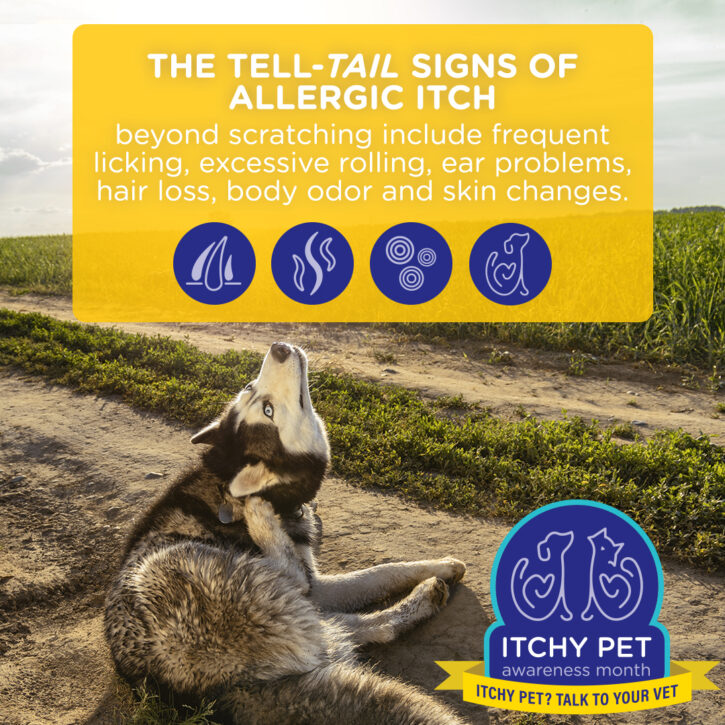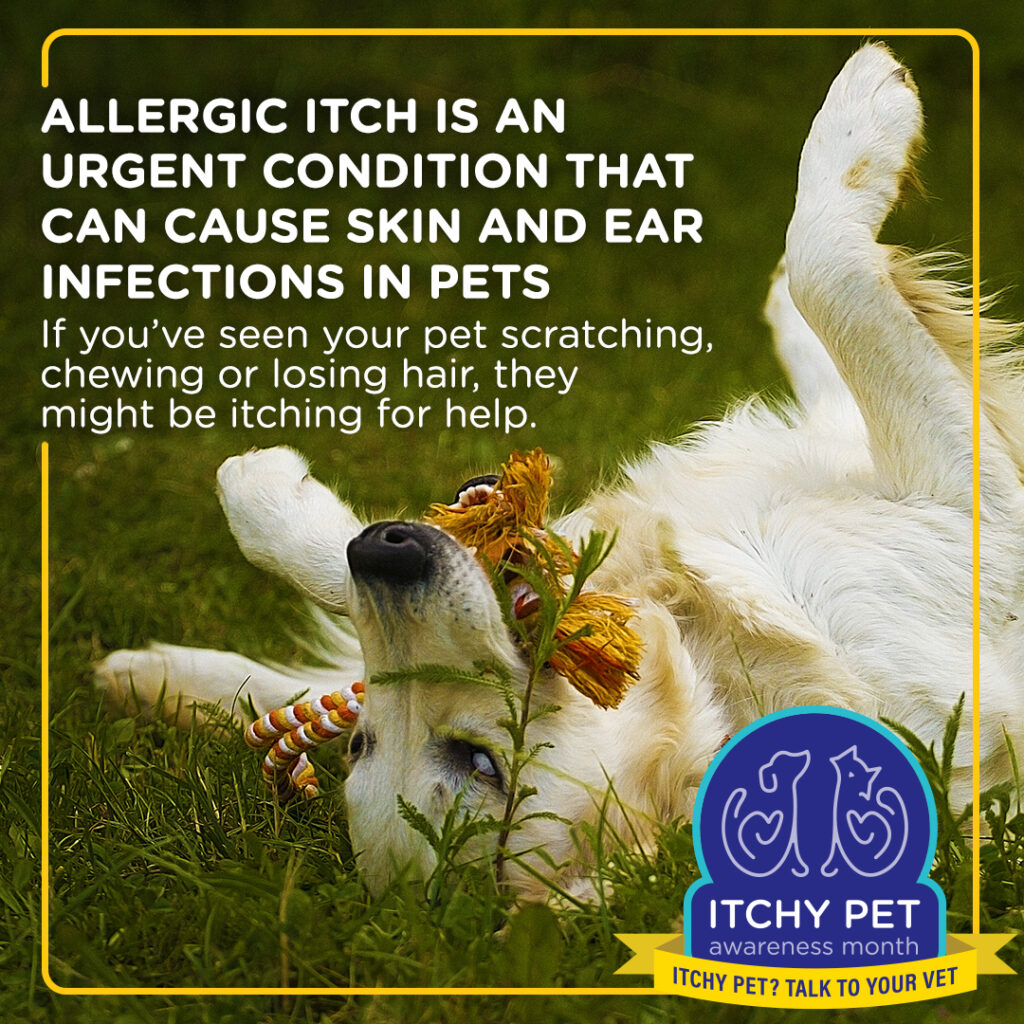
Ditch the Itch: Allergies
Allergies are a very common cause of itchiness in pets. Keep reading to learn more about the different types of allergies in our pets.
Environmental Allergies (Atopy)
Causes
Airborne allergens (pollens, mold, dust particles, etc.) enter the body through defects in the skin (rather than through inhalation like in humans). This causes inflammation in the skin which leads to itchiness and scratching.
Signs
- licking, chewing, biting, or scratching
- excessive rolling, rubbing, or scooting
- recurrent ear infections
- hair loss
- body odor
- rash, redness, greasy skin, or scabs
The most commonly affected areas for itching/licking and hair loss include the feet, belly, areas around the mouth and eyes, and the area around the tail.
Diagnosis
There are a couple of ways to determine if your pet has environmental allergies. The easiest way is to identify patterns to their itching or licking (especially if it seems to be seasonal). Then we want to rule out any parasitic causes. Finally, there is advanced testing that can determine what items (like certain plants or trees) to which your pet is allergic.
Treatment/Management
Treating environmental allergies can be a little more complicated, and it may involve a multimodal treatment plan. This means that your veterinarian may recommend a combination of anti-itch medications, antibiotics (if infection is present), topical shampoos or mousses, various supplements, and other options to help allergies. We will discuss more of those treatments in depth in the next blog post.
Food Allergies
Causes
Food allergies are caused by proteins in the diet, and they often require time to develop. For some reason, the immune system will recognize these proteins as foreign invaders and will “attack” them. This results in inflammation that can affect the gastrointestinal system (often leading to vomiting or diarrhea) as well as the skin.
Signs
- non-seasonal itching
- no response to anti-itch medications (like steroids)
- evidence of chronic vomiting and/or diarrhea (even if intermittent)
- the signs started before 6 months of age or later in life (greater than 5-6 years)
The most common areas affected are the face or neck, paws, belly, around the base of the tail, and ears.
Diagnosis
Unlike environmental allergies, there is no really reliable blood or skin test to determine food allergies. The best way we can truly figure out a food allergy is by doing a diet trial. This consists of feeding a special diet for 8-12 weeks to see if the signs of food allergies resolve. If the itchiness and other signs have resolved by the end of the diet trial, we are more certain that a food allergy was the cause. Then we can always do a challenge trial after that to try to determine which protein in particular was causing the problems.
During a diet trial, it is of the utmost importance that the pet does not receive any other food, supplements, or flavored medication besides the special diet because it can throw off the trial and cause a flare-up of the allergies.
For the most successful diet trial, we recommend using a special diet called a hydrolyzed protein diet. These diets have been specially formulated so that the proteins in the diet have been broken down into small pieces to avoid being recognized by the immune systems. These diets were carefully designed in special facilities so that they do not cause a reaction. There are several options available.
Treatment/Management
The treatment for food allergies is to avoid the protein that causes the allergies. This can be achieved by either feeding the special diet for the rest of your pet’s life, or figuring out which protein is the actual trigger (through a challenge trial) and avoiding that particular protein.
Some pets may need additional medications or treatments to manage any flare-ups or other signs.
Complications
Sometimes pets may have both environmental and food allergies. This can complicate diagnosis and treatment, but that is why it is so important to work with your veterinarian.
Unfortunately, there is no “cure” for allergies – it will be a lifetime of management, and this may take a lot of trial and error to figure out the best treatment plan for your pet.
Now It’s Your Turn!
Test your knowledge with this quiz and be entered into a drawing for some awesome prizes: https://www.allcounted.com/s?did=kxn5jdfu95xnf&lang=en_US.
Resources
Veterinary Information Partner: http://veterinarypartner.vin.com/default.aspx?pid=19239&id=4951475
Veterinary Information Partner: http://veterinarypartner.vin.com/default.aspx?pid=19239&id=4951526
References
Brooks, W., DVM, DABVP (2022, January 5). Allergies: Atopic Dermatitis (Airborne) in Dogs and Cats. VeterinaryPartner. Retrieved August 6, 2023, from https://veterinarypartner.vin.com/default.aspx?pid=19239&id=4951475.
Brooks, W., DVM, DABVP (2022, October 13). Food Allergies in Dogs and Cats. VeterinaryPartner. Retrieved August 6, 2023, from https://veterinarypartner.vin.com/default.aspx?pid=19239&id=4951526.

